Page 460 - TNFlipTest
P. 460
GS58 General Surgery and Thoracic Surgery Breast Toronto Notes 2019
Diagnosis of Breast Lesions: Fine-Needle Aspiration Cytology (FNAC) or Core Needle Biopsy? A Review J Clin Pathol 2012;65:287-292
CNB
• High sensitivity (85%-100%) and specificity (86%- 100%).
• Highsuccessratesfordiagnosisofmalignancyfor palpable lesions (97%), non-palpable lesions (94%), and lesions <10 mm (90%).
• Moreaccurateforhistologicandimmunohistochemistry examinations, and differentiation between in situ and invasive malignancies.
• ReliablefortestingofER,PR,andHER2statusand proliferation assessment.
• Morepainfulprocedure.
FNAC
• Variablesensitivity(35%-95%)andspecificity(48%- 100%).
• Qualitycorrelateswithskillofaspirator.
• Lowersuccessratesfordiagnosisofmalignancyfor palpable lesions (75-90%), non-palpable lesions (34-
58%), and lesions <10 mm (50%).
• High rates of insufficient sampling for lesions >40 mm
or calcified lesions.
• Quicktoperform.
• Lowtechnical costs.
Conclusions: FNAC is preferable for palpable, low malignancy-risk lesions. However, for potential malignancies, CNB is advantageous with respect to prognostication and prediction and is likely cost-effective in the long-term.
Analysis of Circulating Tumour DNA to Monitor Metastatic Breast Cancer
NEJM2013;368:1199-1209
Study: The quantification of circulating tumour DNA, cancer antigen 15-3 (CA 15-3), and circulating tumour cells in 30 women with metastatic breast cancer receiving systemic therapy. The results were compared with radiographic imaging of tumours.
Results/Conclusions: Circulating tumour DNA was detected in 97% of women and showed greater correlation with changes in tumour burden than did CA 15-3 or circulating tumour cells, providing the earliest measure
of treatment response in 53% of women. CA 15-3 and circulating tumour cells were detected in 78% and 87%
of women, respectively. Circulating tumour DNA may therefore be an informative biomarker for metastatic breast cancer.
10 Year Survival after Breast-Conserving Surgery Plus Radiotherapy Compared with Mastectomy in Early Breast Cancer in The Netherlands: A Population- Based Study
Lancet Oncol 2016;17(8):1158
Results/Interpretation: Breast-conserving surgery plus radiotherapy showed improved 10 yr overall and relative survival compared with mastectomy in early breast cancer, but 10 yr distant metastasis-free survival was improved with breast-conserving surgery plus radiotherapy compared with mastectomy in the T1N0 subgroup only, indicating
a possible role of confounding by severity. These results suggest that breast-conserving surgery plus radiotherapy is at least equivalent to mastectomy with respect to overall survival and may influence treatment decision making for patients with early breast cancer.
Lobular Carcinoma in situ (LCIS)
• neoplasticcellscompletelycontainedwithinbreastlobule
• nopalpablemass,andnomammographicfindings;usuallyincidentalfindingonbreastbiopsyfor
another indication
• LCISisariskfactorforinvasivecarcinoma(approximately1%/yr) • treatment
■ if diagnosed on core biopsy, excisional biopsy necessary to rule out malignancy
■ if diagnosed on excisional biopsy, wide excision not needed since LCIS if often multicentric and not
managed as precursor lesion
■ clinical follow-up and surveillance; consider chemoprevention (e.g. tamoxifen)
INVASIVE
Invasive Ductal Carcinoma (most common 80%)
• originatesfromductalepitheliumandinfiltratessupportingstroma
• characteristics:hard,scirrhous,infiltratingtentacles,andgrittyoncross-section
Invasive Lobular Carcinoma (8-10%)
• originatesfromlobularepithelium,20%bilateral
• subtlethickeningoriginatingfromlobes/lobules;usuallypositiveforestrogenandprogesterone
receptors
• harder to detect on mammography due to lack of microcalcifications (may benefit from MRI)
Paget’s Disease (1-3%)
• ductalcarcinomathatinvadesnipplewithscaling,andeczematoidlesion
Inflammatory Carcinoma (1-3%)
• most aggressive form of breast cancer
• ductalcarcinomathatgrowsinnests(vs.solidtumour);invadesandblocksdermallymphatics
• clinicalfeatures:erythema,skinedema,warm,swollen,andtenderbreast±lump,nipplechanges • peaud’orangeindicatesadvanceddisease(IIIb-IV)
Sarcomas: rare
• most commonly phyllodes tumour, a variant of fibroadenoma with potential for malignancy • can also be angiosarcomas – after previous radiation
Lymphoma: rare
Other
• papillary,medullary,mucinous,andtubularcancers • generally better prognosis
Treatment
Table 24. Breast Cancer Treatment by Stage
Stage
0 (in situ) Tis, N0, M0
I
IA: T1, N0, M0 IB: T1, N1mi, M0
II
A: T0, N1, M0 T1, N1, M0 T2, N0, M0
B: T2, N1, M0 T3, N0, M0
III
A: T0, N2, M0 T1, N2, M0 T2, N2, M0 T3, N1, M0 T3, N2, M0
B: T4, N0, M0 T4, N1, M0 T4, N2, M0
Inflammatory IV
any T, any N, M1
Primary Treatment Options
BCS + radiotherapy
BCS alone if margins >1 cm and low nuclear grade Mastectomy* ± SLNB
BCS + axillary node dissection + radiotherapy Mastectomy* + axillary node dissection/SLNB
BCS + axillary node dissection + radiotherapy Mastectomy* + axillary node dissection/SLNB
Likely mastectomy + axillary node dissection + radiotherapy after chemotherapy (neoadjuvant)
Mastectomy + axillary node dissection + radiotherapy
Surgery as appropriate for local control
Adjuvant Systemic Therapy
Consider post-operative tamoxifen for ER+, trastuzumab for HER2+
May not be needed; discuss risks/benefits of chemotherapy and tamoxifen
Chemotherapy for premenopausal women or postmenopausal and ER negative, followed by tamoxifen if ER+
Neoadjuvant therapy should be considered (i.e. pre- operative) especially if not resectable chemotherapy and/ or hormone therapy. Adjuvant radiation and chemotherapy may also be appropriate (i.e. post-operative)
Neoadjuvant therapy
Primary treatment is systemic therapy (i.e. chemotherapy) and/or hormone therapy
BCS = breast conserving surgery; SLNB = sentinel lymph node biopsy
*If no reason to select mastectomy, the choice between BCS + radiotherapy and mastectomy can be made according to patient’s preference since choice of local treatment does not significantly affect survival if local control is achieved


